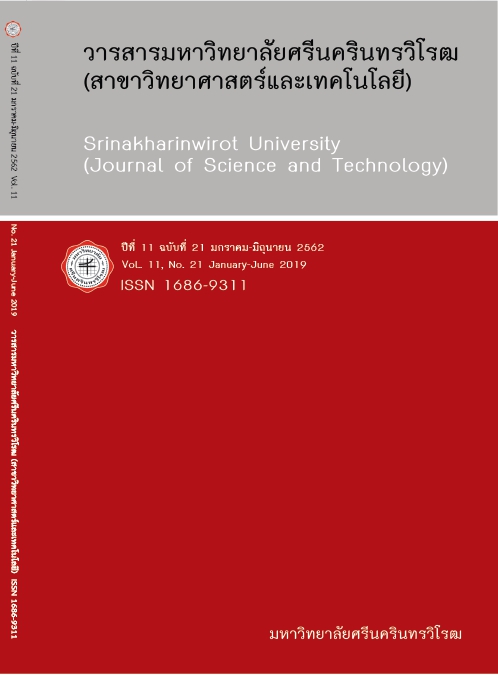ผลของการเตรียมก่อนทอดและวิธีการทอดต่อสมบัติด้านเนื้อสัมผัสและประสาทสัมผัสของถั่วทองทอดกรอบ THE EFFECT OF PRE-FRYING TREATMENTS AND FRYING METHODS ON TEXTURAL AND SENSORY PROPERTIES OF CRISPY FRIED DEHUSKED MUNG BEAN
Keywords:
Dehusked Mung Bean, Snack, Frying, Textural Properties, Sensory PropertiesAbstract
Although fried dehusked mung bean (DM) is a well known nutritious crispy snack in Thailand and other Asian countries, there is rare information regarding its quality and the influence of processing conditions. The objective of this study was therefore to investigate the effect of pre-frying treatments and frying methods on the quality attributes of crispy DM. Expansion ratio, hardness and sensory acceptance (9-point hedonic scale) were quality attributes evaluated for fried DM. Boiling of DM at temperature of 100°C was performed at varied periods of 1, 3 and 5 minutes respectively. The results indicated that boiling periods did not significantly influence on expansion ratio and hardness (p > 0.05) of final product but that for 3 minutes gave the highest overall liking score (p < 0.05). Subsequently, the boiled DM samples with moisture content of 56%w.b. were dried at temperature of 60°C to obtain varied moisture contents of 30, 40 and 50%w.b., respectively. It was found that as the moisture content of pre-fried DM decreased, it’s expansion ratio significantly decreased and hardness significantly increased (p < 0.05). Then pre-fried DM aged at various conditions including atmospheric temperature (approx. 35°C), cooling at 4°C and freezing at -20°C for 12 hours were compared. It was found that ageing of cooked DM at -20°C before frying gave significant increase in expansion ratio, textural liking score and significant decrease in hardness of fried DM (p < 0.05). Nevertheless, the ageing conditions did not significantly effect on liking scores for appearance, colour and overall liking score (p > 0.05). Then the vacuum frying was performed under varied vacuum pressures (23-43 cmHg) and frying temperatures (130-145°C) under equivalent thermal driving force (ETDF) of 60°C and compared with atmospheric condition (76 cmHg, 160°C). The experimental results suggested that frying DM under vacuum pressures of 43 cmHg and temperatures of 145°C gave the highest expansion ratio, the lowest hardness and the lowest water activity (aw) of the fried DM. Sensory evaluation along with SEM structural analysis indicated dramatically improved textural attributes with significantly higher overall liking score of fried DM under vacuum pressure over atmospheric counterpart and local commercial product (p < 0.05).
Downloads
References
[2] Dahiya, Pradeep K.; Linnemann, Anita R.; Nout, Martinus J. R.; Van Boekel, Martinus A. J. S.; Khetarpaul, Neelam K.; and Grewal, Raj B. (2014, February). Consumption habits and innovation potential of mung bean foods in Hisar District of Haryana State, India. Ecololy of Food and Nutrition. 53(2): 171-192.
[3] Dueik, Verónica; Moreno, María Carolina; and Bouchon, Pedro. (2012, August). Microstructural approach to understand oil absorption during vacuum and atmospheric frying. Journal of Food Engineering. 111: 528-536.
[4] Troncoso, Elizabeth.; Pedreshchi, Franco.; and Zuniga, Rommy N. (2009). Comparative study of physical and sensory properties of pre-treated potato slices during vacuum and atmospheric frying. LWT-Food Science and Technology. 42(1): 187-195.
[5] Villareal, Corazon P.; and Juliano, Bienvenido O. (1987, January). Varietal differences in quality characteristic of puffed rice. Journal of Cereal Chem. 64(4): 337-342.
[6] Yang, Chen Shi. (1998). Vacuum frying and oil separation device. U.S. patent 4873920.
[7] Mariscal, M.; and Bouchon, Pedro. (2008, April). Comparison between atmospheric and vacuum frying of apple slices. Food Chemistry. 107(4): 1561-1569.
[8] Oginni, O.C.; Philip, Sobukola Olajide; Henshaw, Folake Olayinka; Afolabi, Wasiu; and Munoz, Loreto A. (2008, December). Effect of starch gelatinization and vacuum frying conditions on structure development and associated quality attributes of cassava-gluten based snack. Journal of Food structure. 3: 12-20.
[9] Chen, C-S.; Chang, C-Y.; and Hsieh, C-J. (2001). Improving the texture and colour of fried products. In J.B. Rossell, editor, Frying: Improving quality, Woodhead Publishing Ltd., pp. 337-358.
[10] Ramesh, Reshma; Shakilab, R. Jeya; Sivaramanb, Balasubramanian; Ponesakki, Ganesana; and Velayuthama, P. (2018, March). Optimization of the gelatinization conditions to improve the expansion and crispiness of fish crackers using RSM. LWT-Food Science and Technology. 89: 248-254.
[11] Yuksel, F.; Karaman S.; Gurbuz M.; Hayta, M.; Yalcin, H.; Dogan M.; and Kayacier, A. (2017, September). Production of deep-fried corn chips using stale bread powder: Effect of frying time, temperature and concentration. LWT-Food Science and Technology. 83: 235-242.
[12] Albertos, Irene; Martin-Diana, Ana B.; Sanz, Miguel Ángeles; Barat, Jose Manuel; Diez, Ana María; Jaime, Isabel.; and Ricoa, Daniel. (2016, February). Effect of high pressure processing or freezing technologies as pretreatment in vacuum fried carrot snacks. Innovative Food Science and Emerging Technologies. 33: 115-122.
[13] SPSS Inc. Released. (2009). PASW Statistics for Windows, Version 18.0. Chicago: SPSS Inc.
[14] Murugasan, Gurunathan; and Bhattacharya, Kshirod R. (1991, January). Effect of some pre-treatment on popping expansion of rice. Journal of Cereal Science. 13: 85-92.
[15] Hoke, K.; Housova, J.; & Houska, M. (2018, February). Optimum condition of rice puffing-Review. Journal of food sciences. 23(1): 1-11.
[16] Su, Ya.; Zhanga, Min.; Zhangc, Weiming.; Liud, Chunquan; and Adhikariea, Benu. (2018, March). Ultrasonic microwave-assisted vacuum fryingtechnique as a novel frying method for potato chips at low frying temperature. Food and Bioproducts Processing. 108: 95-104.
[17] Lusas, Edmund W.; and Rooney, Lloyd W. (2001). Snack Foods Processing. 1st ed. CRC Press.
[18] Van der Sman, Ruud; and Broeze, Jan. (2013, February). Structuring of indirectly expanded snacks based on potato ingredients: A review. Journal of Food Engineering. 114: 413-425.
[19] Rossell, J.B. (2001). Factors affecting the quality of frying oils and fats: Improving quality. Frying:Improving quality. England: Woodhead Publishing Limited.
Downloads
Published
How to Cite
Issue
Section
License
Srinakharinwirot University Journal of Sciences and Technology is licensed Under a Creative Commons Attribution-NonCommercial-NoDerivs 4.0 International (CC-BY-NC-ND 4.0) License, Unless Otherwise Stated. Please Read Journal Policies Page for More Information on Open Access, Copyright and Permissions.



